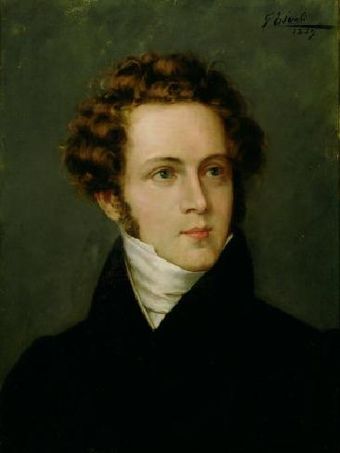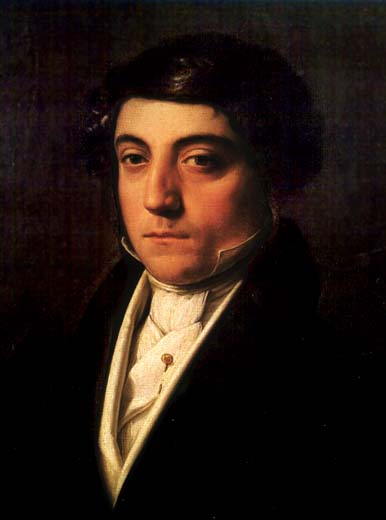Ok, I got scooped. I was working on a blog report to help newbies and myself get a better understanding of what the term “bel canto” means when I am checking the internet on Friday morning, and there is a great piece on the topic from the Washington Post’s Anne Midgette, reference below. So, I decided to move in a different direction and develop a short guide for folks to brush-up on bel canto quickly AND to help spread the word on an excellent chance coming up Friday to hear bel canto in real life. I can’t claim to have my head completely around the topic, but I hope this helps. Here are seven lessons, the last being the most important:
left: Vincenzo Bellini (1801-1835); middle: Gaetano Donizetti (1797-1848); right: Gioachino Rossini (1792-1868). All portraits as a young man. All images in the public domain, copied from Wikipedia. Somehow, I “feel” Donizetti’s seems more bel canto; would you agree?
1. The Italian term “bel canto” means “beautiful singing” or “beautiful song”. It could hardly be more confusing to new fans of opera – all operas have some beautiful singing. I now find it more useful to think of the term as an active statement: “emphasize the voice and singing”. The bel canto era flourished in the eighteenth century and lasted into the early nineteenth, though the term itself was not used until the latter part of the nineteenth. The style remains very popular today – Philadelphia’s Academy of Vocal Arts holds the Giagiari Bel Canto Competition each Fall.
2. Bel canto refers to both a style of singing and a genre of opera, though they go together. Bel canto singing places an emphasis on rules for singing beautifully and on great expressivity in singing. Bel canto opera places an emphasis on the singing within an opera as opposed to the music or the plot.
3. In the popular opera canon, it is safest to think of operas by Rossini, Donizetti, and Bellini as bel canto operas and the arias within them as bel canto arias, though there are examples of bel canto arias in operas by other composers.
4. Though nuanced and complicated, the important elements of bel canto singing are legato (moving smoothly between notes, aided by the open vowels of Italian) and using singing ornamentations such as trills in the higher registers, that demand skill and flexibility in the singer’s voice. Technically, this need for moving facilely and quickly pushes singers to use a lighter sound that they attain mainly by using their head voice, sometimes falsetto, as opposed to pushing more strongly from the bottom of their diaphragm to get more power. Extraordinary singers like Pavarotti could do both.
5. Bel canto operas have distinctive structures of arias and music that places more emphasis on melodies, in particular long melodic lines that allow the singers to improvise and be as musically expressive as they can. Directors of bel canto operas often have to pause the action for several minutes while the singer expresses an emotion in song.
6. There is bel canto music and singing in operas of other periods, but the difference is where the composer places the emphasis overall. So, for example, compare a Wagner opera where words and diction are emphasized in a heavier, more serious style, pushing the story and ideas forward, with a Bellini opera where focus is on conveying individual feelings through beautiful song causing you respond to the emotion and drama even if you don’t know the words.
7. Finally, you don’t have to know any of this to enjoy bel canto singing and opera, but you do have to attend them, and on Friday, April 5 at 7 pm in Lisner Auditorium on the campus of George Washington University, Washington Concert Opera will present Gioachino Rossini’s bel canto opera, Zelmira (1822), in concert, and among the cast will be Lawrence Brownlee who is considered one of the leading bel canto tenors today.
So, go, listen, and enjoy – work on your understanding of bel canto, or not. The distinguishing feature of opera is the human voice, and bel canto opera makes the voice paramount. As operatic styles changed, the bel canto style was characterized by detractors as “empty virtuosity and mere sensual pleasure”; I can agree with that if we remove “empty” and “mere”. Maybe what bel canto really means is this – enjoy the beautiful singing!
For a slightly deeper dive, a few references that go into bel canto in more detail:
“Bel Canto: Audiences Love It, but What Is it? Anthony Tommasini, New York Times, November 28, 2008. Excellent overview, especially of historical placement and structure of bel canto libretto and singing.
Chapter 2: “The Beautiful Song of Italian Opera”; A Mad Love: An Introduction to Opera by Vivien Schweitzer, Basic Books, New York, 2018. An easy read opera book for newbies, includes history and helpful definitions of common terms used in describing bel canto, such as cantabile and cabaletta; it has a good index.
Just appeared - “What exactly is bel canto? It’s a way of singing, and for some, an addiction”, Ann Midgette, Washington Post, March 29, 2019. A beautifully written piece laced with nostalgia and containing links to helpful videos demonstrating key points. Also check out the comments to the article for additional tidbits of information.



